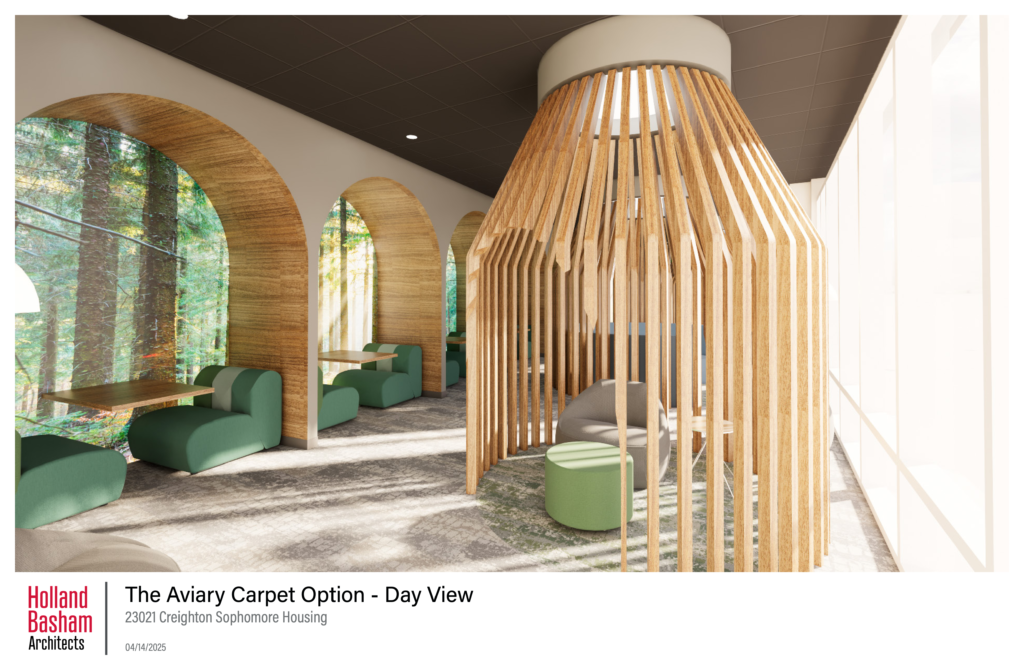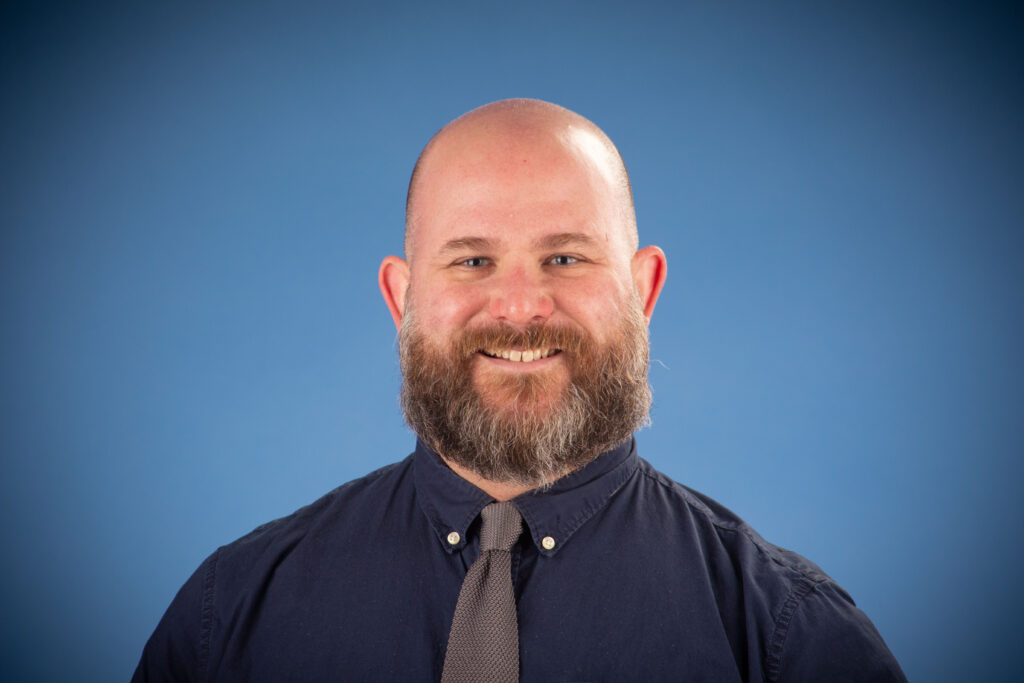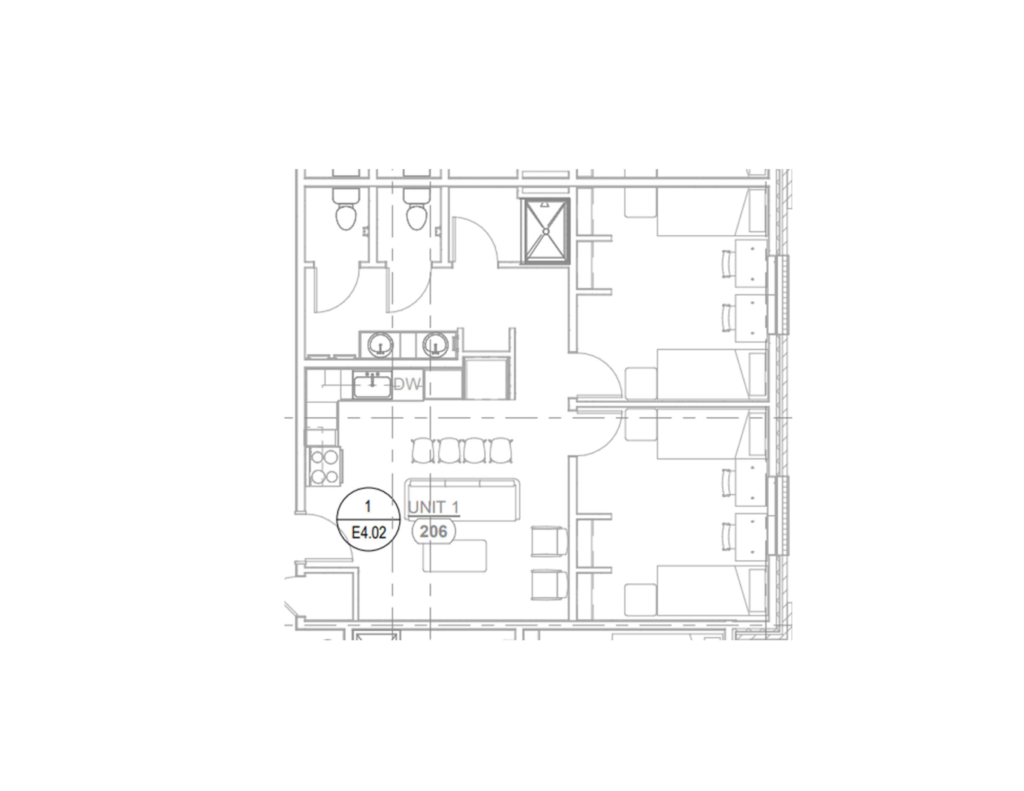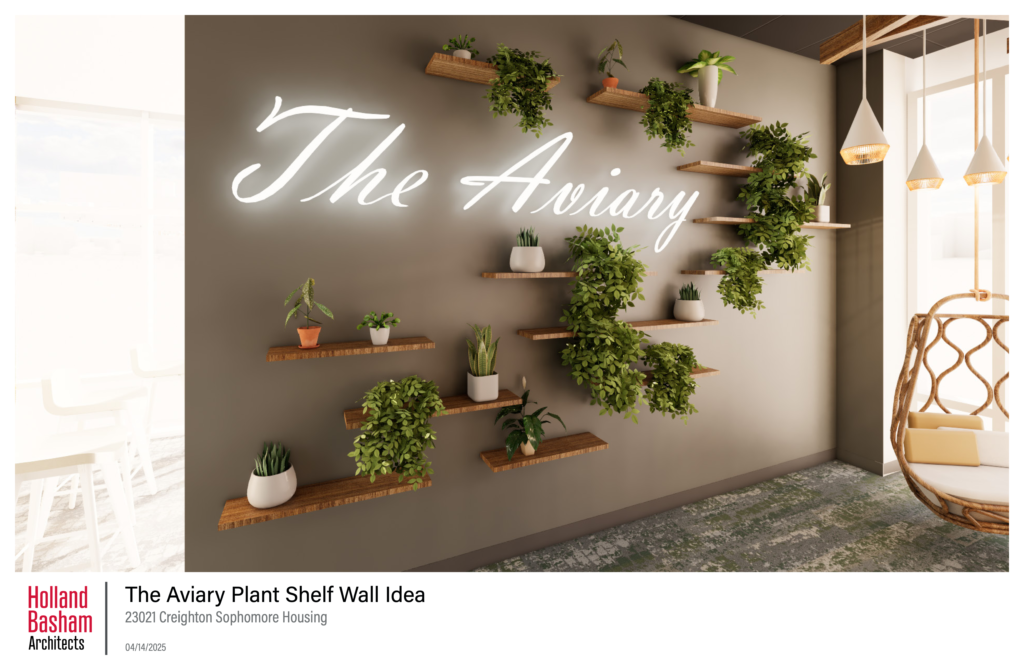
This mock-up illustrates what The Aviary may look like. The Aviary will be a space in the new sophomore residence hall for students to destress.
As Creighton University class sizes continue to grow, questions about whether there is enough on-campus housing to keep up with the rising demand are at the forefront.
Currently, about 2,220 students live on-campus. Opus Hall, the only residence hall which houses upperclassmen, has 282 beds; so, most of these on-campus residents are underclassmen. According to Creighton’s Housing Director Adam Stafford, there is no housing shortage for underclassmen, who are required by the university to live on campus for their first two years, but “we don’t have enough beds for the demand of juniors and seniors that we have.”
“We need to ensure that our freshmen and sophomores students have the space they need on campus, and we work to do that with minimal impact to the number of juniors and seniors we’re able to house on campus, a number which we recognize does not meet the enthusiastic demand we hear from our [upperclassmen] and grad/professional school students,” Stafford said. “Right now, that means housing as many as we can, and/or temporarily expanding our footprint through other avenues, while we work with the university to determine the best route forward over the next ten or so years. Conversations are happening, scenarios are being considered, but the student experience is always at the forefront of our minds.”
The newest residential building for students on campus, Graves Hall, houses 404 students. Kiewit Hall, a freshmen residence hall that was torn down in 2024, housed around 480 students. Gallagher Hall, which also housed freshmen, was torn down in 2022.
“[When Gallagher was torn down] Creighton was projecting that our number of freshmen would start declining. The enrollment projections were sort of small incremental steps down. So, …with what the projection was when all of those decisions were made, we had enough beds in Swanson, Graves and Deglman to handle freshmen and then, eventually, we would need to start taking over McGloin. But I guess doing really well in the March Madness tournament or something [made more students commit to Creighton]. The last couple of years we were within what we call our wiggle room, our overflow space,” Stafford said. Working within this overflow space, some double rooms in Swanson Hall have been converted into triples and freshmen were moved into McGloin Hall earlier than originally planned.
According to Stafford, part of why Graves was not built with additional floors to house more freshmen is due to construction costs. Structures of four-stories or less can be built with wood lumber framing. Taller buildings require concrete. The building’s structure and, usually, the elevator structure changes when it’s taller.

Director of Housing and Auxilary Services
“So, you start to add on additional costs to go up in that tower style,” Stafford said.
Stafford also said that even though class sizes, contrary to previous projections, are increasing, Creighton is not issuing more acceptances.
“I don’t want to speak for admissions, but from my understanding, …[Creighton is] not trying to make class sizes bigger,” Stafford said. “…We’ve had the same number of qualified applicants [and] the same number of offers go out, [but more students are accepting those offers]. If one or two or three percent more students go ‘Creighton is where I want to be,’ that’s a huge swing. … When things are going really well for Creighton, those factors can add up really quickly. So, it’s not that the university is doing anything differently, not admitting more students. In fact, I think starting last year, they actually admitted fewer and then still had the third highest class. So, that’s part of the challenge that my team faces — how do we balance all of these needs and build in enough variability to try to soften the impact on students.”
Furthermore, Stafford said that last year the retention rate for the freshmen to sophomore class was about 94% instead of the typical 92% or 93%.
This semester, freshmen are living in Graves Hall, Deglman Hall, Swanson Hall and the first and second floors of McGloin Hall; sophomores are living in Kenefick Hall, Heider Hall, Davis Square, the third through fifth floors of McGloin and some are in Opus Hall; and the upperclassmen who live on campus are all in Opus.
Additionally, some athletes, including underclassmen, are living in The Atlas Apartments and paying Creighton the Opus rate, according to Stafford.
“The reason we started with that group was because it was in the middle of the summer [and] many of them were still here or coming back for practices, and they had a built-in community and support system that already existed. So, we felt like with that short amount of time that we had to respond, that was a good sort of right-sized group that we could get moved pretty quickly, and didn’t have to worry about whether they would be feeling disconnected from campus,” Stafford said.
As of Tuesday, there is a strong possibility that some upperclassmen ROTC cadets, who have room and board covered by the university, may also be moved into apartments like The Atlas next academic year to make room for more sophomores in Opus. At that time, Stafford said the decision had yet to be finalized.
Creighton is able to move some students into these apartments because, according to Stafford, the university has a good relationship with NuStyle, the property developer that owns The Atlas and other apartment complexes such as The Highline Apartments.
“They’ve [NuStyle] been really easy to work with for us, and I think if I’m going to ask a student to consider moving from Opus to an off-campus apartment, The Atlas is a natural fit [because of] the skywalk [and] it’s right there,” Stafford said.
This is a temporary solution while the university works to develop a long-term plan to address housing needs.

A floor plan for dorm rooms in the new hall.
So, while some students have been moved into The Atlas and more may be moved there in the future, no students are currently living in hotels instead of on-campus housing, and there are no plans for this to happen, which is a rumor that Stafford said he wished to quell.
In the fall of 2026 a new sophomore residence hall, which is currently being constructed on Burt Street, will open and make 400 more beds available on campus.
The dorms in this building will be apartment-style with a living room, a full kitchen, two bedrooms (which will each be shared by two students) and a bathroom. The bathroom will have a shower and two toilets each separated by their own door, as well as two sinks. The living room will have a couch with side tables instead of a coffee table, a high-top table with barstools behind the couch, armchairs and a TV center.
“One of the problems that I aimed to solve with next hall is that, when we do re-contracting for rising sophomores, 85-plus percent of students preference Davis as their first choice. It’s less than 300 beds, I can’t give Davis to everyone who wants Davis. … I didn’t want to build a new hall that just takes Davis’ place as the new 85% preference building. I really wanted to try to smooth that preference out. I really believe everybody needs to find the one that works for them, rather than there just being one that works for everybody. … So, I don’t think it’s actually that controversial, but I will say my controversial decision here is that next hall is double occupancy bedrooms,” Stafford said.
Similarly to Graves, the new hall will also have areas open to all Creighton students, including administrative spaces, study nooks, huddle rooms similar to those in the Mike & Josie Harper Center and a small classroom.
It will also have a space called The Aviary open to all students.
“In my mind, I want it to be a place where students can come and destress, unplug, move away from some digital toxicity [and] just connect with each other or have some mindfulness space,” Stafford said. “So, I always joke, if it were up to me, your cell phones wouldn’t work in this space — but they will.”
The Aviary concept comes from the idea of a nest. It is designed to be more homey than most campus spaces and will include a lot of brown and green hues, in addition to other natural elements like wood and live plants. The seating in the space will include hanging chairs. It will also have a sound system that might be programmed with nature sounds, low-level grey sounds or even light jazz.
“Who knows what we could do?” Stafford said with a smile and healthy enthusiasm. He added, “[I’m] looking forward to seeing how students use it, and I hope it’s in such high demand that we need to build similar spaces on campus to destress and reconnect!”
The new hall will also have a shared kitchen with a roll-out door onto a patio space.
“When the weather is really great, you can just throw the doors open. It’s a nice space to come and go, to cook, to grill hamburgers and then go eat on the patio. … They all have their kitchens, so why have a community kitchen? I wanted this to be a space where Sodexo could come in and do cooking lessons or we could do programming around watching and talking through cooking,” Stafford said.
After that residence hall opens, Stafford said the current plan is to fully convert McGloin into a freshmen-only hall. That will involve renovating the building to make it more conducive to freshmen. This may include adding a kitchen to the first-floor lounge and converting current kitchens into private study spaces.

Pictured above is a mock-up what another part of The Aviary could look like in the new hall.
At this point in time, the plan is for Deglman to continue to stay open for freshmen.
“Every residence hall has sort of its usable lifespan at which point, you know, you either have to renovate or let it go. … Right now… we don’t have active plans. … Students will be living there next year,” Stafford said.
A long-term plan for on-campus housing is still evolving. Creighton is currently working with a firm to conduct a market study to evaluate student needs. Stafford said they are looking at the demand for housing and what students are desiring. The ongoing study has sent out surveys to students and conducted focus groups.
“[It’ll] basically help us develop where do we go over the next 10 years,” Stafford said.
“It’s all being driven by the thing that I think every day: students want to live on campus, living on campus makes a difference. How can I better provide that experience for students?”
-Adam Stafford, Housing and Auxiliary Services Director
Stafford made it clear that he wants to help students have the best on-campus living experience that they can. As a Creighton alum himself, Stafford is a former Kiewit resident, a previous resident advisor and a former assistant resident director. So, he understands on-campus housing needs from both the student and administrative perspectives.
“I do this work because when I lived in a residence hall, it made a huge difference for me. … It’s all being driven by the thing that I think every day: students want to live on campus, living on campus makes a difference. How can I better provide that experience for students?” Stafford said.
He added, “I just really want to invite [students] to know that we hear them. We know that this experience is important to them. It matters to them. It’s something they value, and we want to match the way they value that with a wider footprint. I’m not sure today how we’ll get there, but we’re talking about it a lot. … And if they have questions or concerns, [the Housing and Residence Life Suite is] in one of the residence halls for a reason. I would love for them to come and talk to us.”